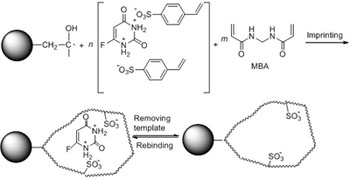[1] Udo, K.; Hokonohara, K.; Motoyama, K.; Arima, H.; Hirayama, F.; Uekama, K. Int. J. Pharm. 2010, 388, 95.
[2] Dev, R.; Kumar, B. V.; Pathak, K. Int. J. Pharm. 2011, 411, 142.
[3] Das, S.; Ng, K. Y. Int. J. Pharm. 2010, 385, 20.
[4] Freire, C.; Podczeck, F.; Veiga, F.; Sousa, J. Eur. J. Pharm. Biopharm. 2009, 72, 587.
[5] Cai, X.; Yang, L. Q.; Zhang, L. M.; Wu, Q. Bioresource Technol. 2009, 100, 4164.
[6] Basan, H.; Gümüsderelioglu, M.; Orbey, T. M. Eur. J. Pharm. Biopharm. 2007, 65, 39.
[7] Makhlof, A.; Tozuka, Y.; Takeuchi, H. Eur. J. Pharm. Biopharm. 2009, 72, 1.
[8] Karrout, Y.; Neut, C.; Wils, D.; Siepmann, F.; Deremaux, L.; Flament, M. P.; Dubreuil, L.; Desreumauxd, P.; Siepmann, J. Eur. J. Pharm. Sci. 2009, 37, 427.
[9] Xi, M. M.; Zhang, S. Q.; Wang, X. Y.; Fang, Q.; Gu, Y. Int. J. Pharm. 2005, 298, 91.
[10] Perera, G.; Barthelmes, J.; Bernkop-Schnürch, A. J. Controlled Release 2010, 145, 240.
[11] Mastiholimath, V. S.; Dandagi, P. M.; Jain, S. S.; Gadad, A. P.; Kulkarni, A. R. Int. J. Pharm. 2007, 328, 49.
[12] Byun, H. S.; Youn, Y. N.; Yun, Y. H.; Yoon, S. D. Sep. Purif. Technol. 2010, 74, 144.
[13] Uzun, L.; Say, R.; ünal, S.; Denizli, A. J. Chromatogr. B 2009, 877, 181.
[14] Yuan, Y.; Wang, Y. Z.; Huang, M. D.; Xu, R.; Zeng, H.; Nie, C.; Kong, J. H. Anal. Chim. Acta 2011, 695, 63.
[15] Tan, X. C.; Wang, L.; Li, P. F.; Gong, Q.; Liu, L.; Zhao, D. D.; Lei, F. H.; Huang, Z. Y. Acta Chim. Sinica 2012, 70, 1088. (谭学才, 王琳, 李鹏飞, 龚琦, 刘力, 赵丹丹, 雷福厚, 黄在银, 化学学报, 2012, 70, 1088.)
[16] Wang, C. Y.; Javadi, A.; Ghaffari, M.; Gong, S. Q. Biomaterials 2010, 31, 4944.
[17] David, C.; Kirby, A.; Alexander, C. Adv. Drug Delivery Rev. 2005, 57, 1836.
[18] Azodi-Deilami, S.; Abdouss, M.; Javanbakht, M. Appl. Biochem. Biotechnol. 2011, 164, 133.
[19] Singh, B.; Chauhan, N. Acta Biomater. 2008, 4, 1244.
[20] Suedee, R.; Bodhibukkana, C.; Tangthong, N.; Amnuaikit, C.; Kaewnopparat, S.; Srichana, T. J. Controlled Release 2008, 129, 170.
[21] Hauff, E. V.; Fuchs, K.; Hellmann, D. C.; Parisi, J.; Weiler, R.; Burkhardt, C.; Kraushaar, U.; Guenther, E. Biosens. Bioelectron. 2010, 26, 596.
[22] Muzzalupo, R.; Tavano, L.; Cassano, R.; Trombino, S.; Cilea, A.; Picci, N. Eur. Polym. J. 2010, 46, 209.
[23] Dev, R. K.; Bali, V.; Pathak, K. Int. J. Pharm. 2011, 411, 142.
[24] Lei, L.; Liu, X.; Guo, S. R.; Tang, M.; Cheng, L.; Tian, L. J. Controlled Release 2010, 146, 45.
[25] Lee, S. C.; Chan, J. Y.; Pervaiz, S. Cancer Lett. 2010, 288, 36.
[26] Men, J. Y.; Gao, B. J.; Chen, Z. P. Acta Polym. Sin. 2012, (9), 943. (门吉英, 高保娇, 陈志萍, 高分子学报, 2012, (9), 943.)
[27] Arslan, H.; Hazer, B. Eur. Polym. J. 1999, 35, 1451.
[28] Yagci, C.; Yildiz, U. Eur. Polym. J. 2005, 41, 177.
[29] Liu, S. Y.; Gao, B. J.; Fu, H. Y. Acta Polym. Sin. 2010, (6), 727.(刘苏宇, 高保娇, 付红艳, 高分子学报, 2010, (6), 727.)
[30] Hiorth, M.; Skøien, T.; Sande, S. A. Eur. J. Pharm. Biopharm. 2010, 75, 245. Muzzalupo, R.; Tavano, L.; Cassano, R.; Trombino, C. S.; Picci, A. N. Eur. Polym. J. 2010, 46, 209.


